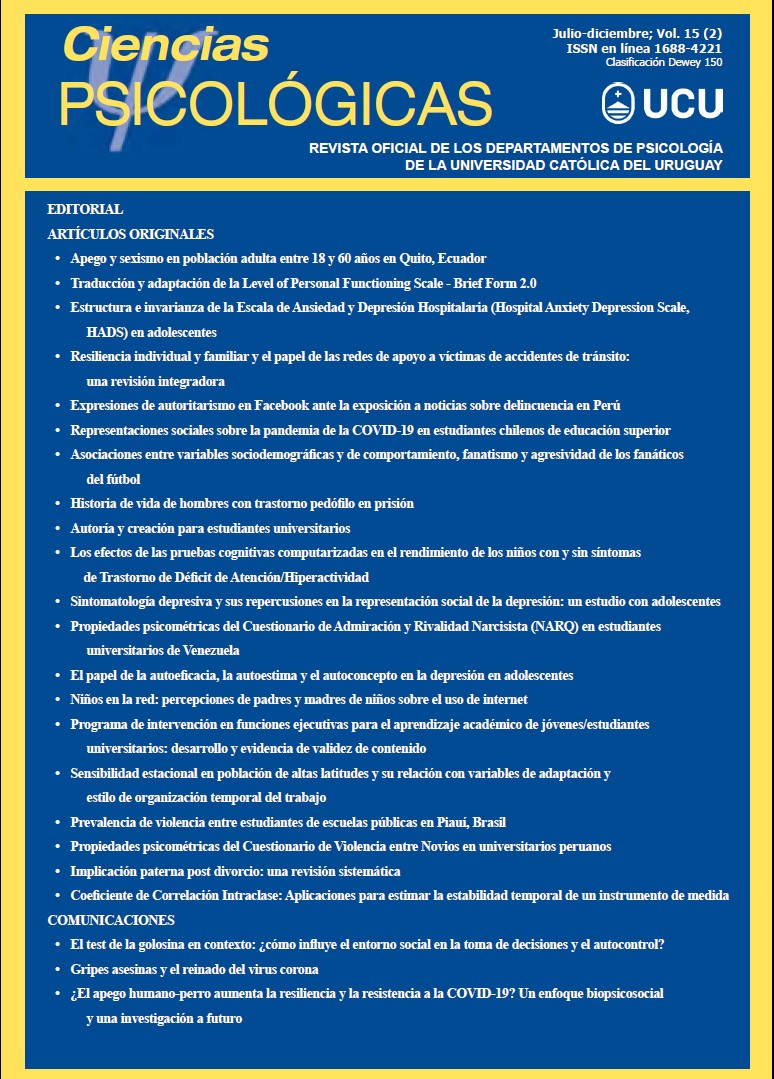Life history of men with pedophilic disorder serving time in prison
DOI:
https://doi.org/10.22235/cp.v15i2.2149Keywords:
pedophile disorder, pedophile, child sexual abuseAbstract
This study’s objective was to understand the life story and romantic relationships of men serving time for the rape of children and/or adolescents and the circumstances under which the crimes were committed. This is a qualitative study with a multiple-case design. Three men diagnosed with pedophilic disorder, convicted of sexual violence against children and/or adolescents participated. The following instruments were used: a sociodemographic form and semi-structured interviews. The results revealed that the victimizers consider that sexual interactions with children/adolescents are appropriate, provided not very young children or violence is involved. They acknowledged their disorder only in terms of immaturity. In addition to criminal punishment, psychological counseling provided to pedophiles is vital to prevent relapses.
Downloads
References
Aebi, M., Landolt, M. A., Mueller-Pfeiffer, C., Schnyder, U., Maier, T., & Mohler-Kuo, M. (2015). Testing the “sexually abused-abuser hypothesis” in adolescents: A population-based study. Archives of sexual behavior, 44(8), 2189-2199. doi: https://doi.org/10.1007/s10508-014-0440-x
American Psychiatric Association [APA]. (2013). Diagnostic and statistical manual of mental disorders (DSM-5). Washington: American Psychiatric Association.
Arakaki, F. F. S., Hastenreiter, K. K. C. S., Oliveira, R. T. D. S. A., Guerra, S. L., & Souza, V. A. (2019). Uma Análise Multifacetada do Abusador Infantil: a Controvérsia entre Portadores do Transtorno Pedofílico e Agressores Sexuais. Anais do Seminário Científico do UNIFACIG, (4).
Baltieri, D. A. (2013). Pedofilia como transtorno comportamental crônico e transtornos comportamentais assemelhados. Brasília Médica, 50(2), 122-131.
Barros, C. D. A. (2017). Parafilias, Pedofilia e Intervenções em Terapia Cognitivo-Comportamental. PSIQUE, 2(3), 78-94.
Casarin, J. M., Botelho, E. H. L., & Ribeiro, R. K. S. M. (2016). Ofensores sexuais avaliados pelo Desenho da Figura Humana. Avaliação Psicológica, 15(1), 61-72.
Castro, M. E., López-Castedo, A., & Sueiro, E. (2009). Sintomatología asociada a agresores sexuales en prisión. Anales de Psicología, 25(1), 55-51.
Demidova, L. Y., Zobnina, N. V., Dvoryanchikov, N. V., Vvedensky, G. E., Kamenskov, M. Y., & Kuptsova, D. M. (2020). Altered Perception of Age in Pedophilia and Pedophilic Disorder. Clinical Psychology and Special Education, 9(1), 104-120. doi: https://doi.org/10.17759/cpse.2020090106
Etapechusk, J., & Santos, W. D. V. (2017). Um estudo sobre o sujeito pedófilo, uma visão da psicologia. Psicologia pt. Retrieved from: https://www.psicologia.pt/artigos/textos/A1176.pdf
Herrero, Ó., & Negredo, L. (2016). Evaluación del interés sexual hacia menores. Anuario de Psicología Jurídica, 26(1), 30-40. doi: https://doi.org/10.1016/j.apj.2016.04.007
Jahnke, S., Imhoff, R., & Hoyer, J. (2015). Stigmatization of people with pedophilia: Two comparative surveys. Archives of sexual behavior, 44(1), 21-34. doi: https://doi.org/10.1007/s10508-014-0312-4
Marafiga, C. V., & Falcke, D. (2020). Perfil sociodemográfico, judicial e experiências na família de origem de homens que cumprem pena por estupro de vulnerável. Aletheia, 53(2). doi: https://doi.org/10.29327/226091.53.2-7
Marafiga, C. V., Falcke, D., & Teodoro, M. L. (2017). Pedofilia: história de vida e o retorno para a família por meio de alta progressiva. Revista da SPAGESP, 18(1), 48-62.
Margolin, G., Vickerman, K. A., Ramos, M. C., Serrano, S. D., Gordis, E. B., Iturralde, E., ... & Spies, L. A. (2009). Youth exposed to violence: Stability, co-occurrence, and context. Clinical child and family psychology review, 12(1), 39-54. doi: https://doi.org/10.1007/s10567-009-0040-9
Marsden, V. F. M. G. (2009). Pedofilia, transtorno bipolar e dependência de álcool e opioides. Jornal Brasileiro de Psiquiatria, 58(2), 119-121. doi: https://doi.org/10.1590/S0047-20852009000200009
Monteiro, D. V. X. (2012). Crimes sexuais contra crianças: Pedófilo vs. Molestador sexual. Physis, 27(3).
Muse, M., & Frigola, G. (2003). La evaluación y tratamiento de trastornos parafílicos. Cuadernos de médicina psicosomatica y psiquiatria de enlace, 65, 55-72.
Passarinho, M. C. B. T. (2015). O fenómeno do abuso sexual de crianças: O abusador intra-familiar e o extra-familiar (Tese de doutorado, ISPA). Retrieved from: http://repositorio.ispa.pt/handle/10400.12/4547
Ramírez Torres, A., & Vanegas Garcia, J. H. (2020). Estructura cognitiva de las emociones sociales intervinientes en la comisión de delitos sexuales. Tesis Psicológica, 16(1), 1-33. doi: https://doi.org/10.37511/tesis.v16n1a11
Reis, D. C., & Cavalcante, L. I. C. (2019a). Avaliação de distorção cognitiva de autores de agressão sexual de criança e adolescente, AASCAS: revisão sistemática da literatura. Revista da SPAGESP, 20(2), 99-116.
Reis, D. C., & Cavalcante, L. I. C. (2019b). Revisão sistemática dos instrumentos de avaliação cognitiva de autores de agressão sexual contra criança e adolescente (AASCA). Revista Subjetividades, 18(3), 13-25. doi: https://doi.org/10.5020/23590777.rs.v18i3.6525
Santos, A. S. F., & Mesquita, A. C. C. (2019). O perfil do agressor sexual infantil: uma revisão bibliográfica. Revista Educação, Psicologia e Interfaces, 3(2), 85-100. doi: https://doi.org/10.37444/issn-2594-5343.v3i2.212
Schinaia, C. (2000). Pedofilia, pedofilias. Rev. de Psicoanalisis, 7, 79-101.
Schinaia, C. (2015). Pedofilia Pedofilias: A Psicanálise e o mundo do Pedófilo. São Paulo: Editora da Universidade de São Paulo.
Scortegagna, S. A., & do Amparo, D. M. (2013). Avaliação psicológica de ofensores sexuais com o método de Rorschach. Avaliaçao Psicologica: Interamerican Journal of Psychological Assessment, 12(3), 411-419.
Seto, M. C., Babchishin, K. M., Pullman, L. E., & McPhail, I. V. (2015). The puzzle of intrafamilial child sexual abuse: A meta-analysis comparing intrafamiliar and extrafamilial offenders with child victims. Clinical Psychology Review, 39, 42-57. doi: https://doi.org/10.1016/j.cpr.2015.04.001
Soldino, V., & Carbonell-Vayá, E. J. (2017). Effect of treatment on sex offenders’ recidivism: a meta-analysis. Annals of Psychology, 33(3), 578-588. doi: https://doi.org/10.6018/analesps.33.3.267961
Stein, D. J., Black, D. W., & Pienaar, W. (2000). Sexual disorders not otherwise specified: compulsive, addictive, or impulsive? CNS spectrums, 5(1), 60-66. doi: https://doi.org/10.1017/S1092852900012670
Van Leeuwen, M. L., Van Baaren, R. B., Chakhssi, F., Loonen, M. G., Lippman, M., & Dijksterhuis, A. (2013). Assessment of implicit sexual associations in non-incarcerated pedophiles. Archives of sexual behavior, 42(8), 1501-1507. doi: https://doi.org/10.1007/s10508-013-0094-0
Williams, L. C. A. (2012). Pedofilia: identificar e prevenir. São Paulo: Brasiliense, 112.
Yin, R K. (2010). Estudo de Caso - Planejamento e Métodos. (4ª ed.). Porto Alegre: Artmed.
Downloads
Published
How to Cite
Issue
Section
License
Copyright (c) 2021 Universidad Católica del Uruguay

This work is licensed under a Creative Commons Attribution 4.0 International License.
















